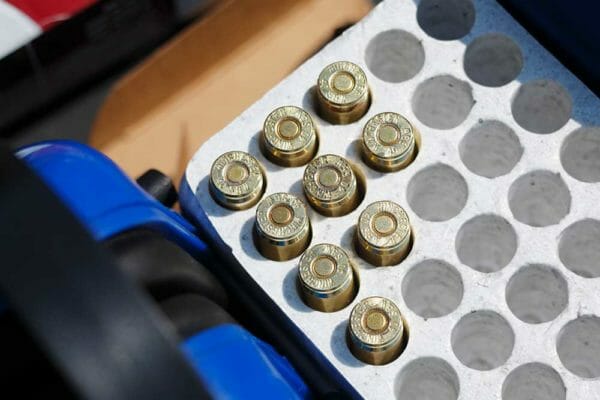
U.S.A. –-(AmmoLand.com)- For a brief time, .40S&W was quite possibly the most popular service caliber in the United States. Legions of law enforcement agencies chose it for their duty guns, and the civilian market followed suit. Even today, certain demographics still fawn over the forty.
However, times are changing. In the early 2010’s the FBI began returning to the 9mm they’d abandoned less than two decades prior, with many others in law enforcement and the citizen world following suit. With this in mind, are there reasons why someone would choose a handgun chambered for .40S&W as their primary pistol in 2022? Let’s find out.
Shortcomings of 40S&W
Slightly More Expensive
The price difference between 9mm and .40S&W has typically been minor over the past several years. However, there has consistently been a difference, with 9mm usually being on the less expensive end of the spectrum. As of the time of this writing, .40S&W retails online for roughly $0.03-0.06 more per round than comparable practice loads of 9mm for cases of 1,000 rounds. This results in roughly $30-60 more per case when shooting .40S&W. Duty ammunition, seems to be roughly equivalent in price between the two, though 9mm enjoys far more availability and a wider variety of options than its bigger brother.
These differences in price are fairly minimal but can add up over time. I don’t think a few extra pennies here and there will break most people’s banks, but as belts continue to tighten, the extra expense could prove detrimental for many shooters.
More Difficult to Shoot
One of the biggest issues people have with .40S&W is increased recoil compared to 9mm. As a young shooter with a Glock 23, I had a hell of a time getting used to the sharp snap from the plastic fantastic compared to the mild puff from the Beretta M9 I’d traded away. One of the primary reasons cited by the FBI in their shift away from .40S&W is due to the relatively harsh recoil, contributing to reduced accuracy among their agents. Wanting to quantify this difference, I headed to the range to see how they compared for myself.
Range Time
To get as equal comparison as possible with the equipment available to me, I opted to shoot a Glock 34 in 9mm and a Glock 22 in .40S&W. While the G34 does have a longer sight radius, the difference is fairly negligible in my experience. Both guns were 4th generation Glocks outfitted with factory iron sights, with no modifications.
As expected, my performance was better with the 9mm pistol. However, the differences were far less substantial than I imagined I would see. I fired several drills with both pistols, giving each three repetitions per drill to get an average of performance. To ensure .40S&W had a fair chance, I shot the drills cold to avoid any differences in my shooting.
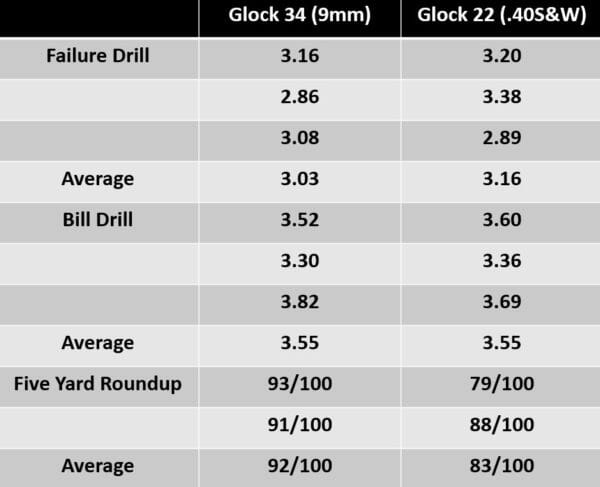
To top things off, the G22 was significantly more pleasant to shoot than I prepared myself for. This was honestly a shock for me, as my prior experiences with most .40S&W pistols has been very negative in terms of shootability. This of course can be impacted by ammunition selection, and is highly subjective in the first place. That being said, numbers don’t lie. While the differences are fairly minor, there is a distinct degradation of performance when moving from 9mm to .40S&W. Even with this degradation, I wouldn’t feel significantly disadvantaged with of forty in my waistband.
Increased Parts Wear
This is something that the vast majority of shooters will never have to worry about. That being said, it is something to consider for even mildly serious shooters, those buying used firearms, or people looking to adopt firearms for their agency/organization/whatever. Thanks to the increased pressures associated with .40S&W, users will see increased parts wear compared to 9mm and .45ACP service pistols. But don’t take my word for it.
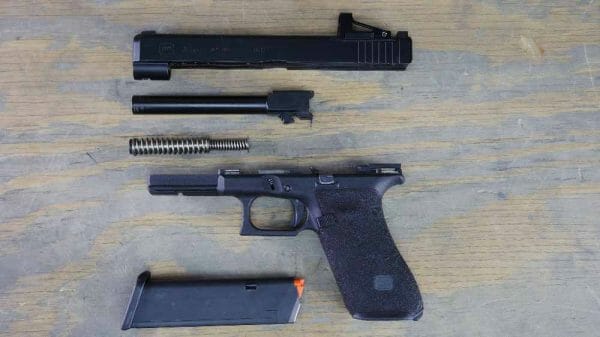
Recently Greg Ellifritz, of Active Response Training, spoke to common parts breakage on Glock handguns and how to properly maintain them. With experience maintaining the pistols for his agency, and as a national level trainer, Greg has a lot of insight into the subject. Due to this, I asked for his input regarding the differences in parts life between 9mm and .40S&W pistols. Here’s what he had to say:
“My department issued 9mm, .40, and .45 Glocks. I worked on all of them. The .40s would have parts break at 2-3x the rate of 9s and .45s. I think the overall service life is probably pretty equal but you are going to have to do more work to keep the .40s going.”
To add to this, I spoke with Reid Henrichs of Valor Ridge. Reid was the first national-level instructor I trained with back in the fall of 2017. During the course of training, he spoke to the shorter service life of .40S&W handguns compared to their 9mm counterparts. Recently I reached out to Reid for his updated take on the subject. Here’s what he had to say:
“I have seen about 6 pistols blow up on the range, all of them .40 S&W. Some were using reloads but some were not. I have never seen a 9mm blow up. In terms of service life of a pistol, the 9mm Glocks have about a 4-5X longer life than the .40. You will get about 30-50k rounds from a G22/23 and easily 100k+from a G17/19.
The parts that break are the slide and frame. Small cracks become big ones. In terms of maintenance, they are equal as you need to replace the recoil springs every 5k rounds. Other springs should be replaced annually. My range gun, a gen 3 G19 has 120K through it right now and is still going strong.”
No Additional Stopping Power
“Stopping power” is difficult to quantify. We can use ballistics gelatin tests to measure expansion, penetration, and more, but those aren’t a 1:1 comparison of performance against a living threat. We can spend days cherry-picking examples of X round performing perfectly or Y round underperforming. This goes for caliber debates, preferred defensive loads, and even different bullet weights within the same caliber and brand. What truly matters here is good shot placement with a quality round.
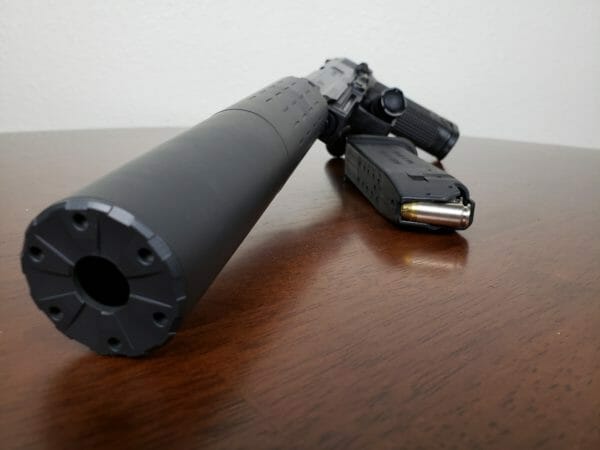
We’re not here to focus on anatomy today, so we’ll instead discuss what advantages, if any, .40S&W holds of 9mm in the realm of “stopping power”. Turns out the differences between most service calibers are negligible. Whether you’re shooting a 9, 40, or 45, penetration and even expansion are often comparable with quality defensive ammunition.
Several studies have been conducted on this, such as those from Doctor Gary Roberts, Greg Ellifritz, and others. If that’s not enough, the FBI speaks in detail about the myth of stopping power, or any perceived benefits of larger calibers in their whitepaper explaining their switch back to 9mm for service pistols. With several leading experts in the industry all coming to the same independent conclusions, this may be a clue.
Of course this means that .40S&W is perfectly adequate for personal protection. Nobody is arguing that point. But is the juice worth the squeeze when the results are the same at the cost of the other issues mentioned above? Is seems like most people are saying no.
Benefits of 40S&W
If you’ve made it this far, you’re probably thinking that I hate .40S&W. If you asked me a few months ago, the answer would’ve been yes. That being said, I’m not as opposed to it now as I was in the past. There certainly are some benefits to the round. What are they?
Competitive Edge
Some competitive shooting bodies offer different divisions for different calibers, typically based off of Power Factor. In simple terms, Power Factor is bullet weight multiplied by velocity measured in feet per second. Theoretically, a higher power factor means higher recoil. Baselines are established for different power factors, ensuring that shooters don’t load severely underpowered ammunition for an unfair advantage.
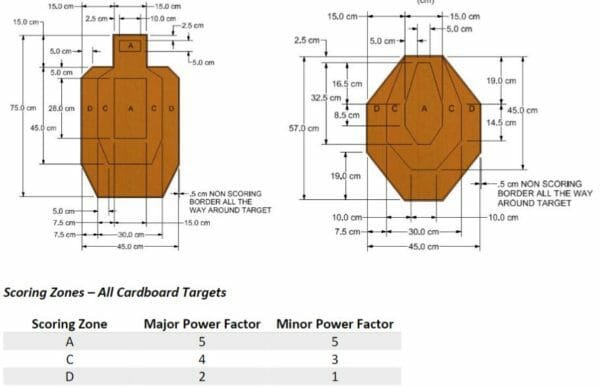
USPSA has two Power Factors, Major and Minor, with Major offering more points for hits outside the A-Zone of the target. This leads many shooters to choose Major, allowing for a little more grace for thrown shots. An easy way to make Major Power Factor is to use heavier bullets, which is often thought to produce lower recoil than choosing higher velocity rounds. A bigger bullet is easier to make heavier. As such, we see .40S&W dominate Limited division in USPSA, allowing for Major, while also providing improved capacity over something like a .45ACP.
Caliber Conversions
Some guns allow you to swap a few parts and convert them into other calibers. My Glock 31, for example, can be easily converted to shoot .40S&W, and 9×19 while still using the same holsters. Often times people tout this as a selling point for guns chambered in .40S&W, as most are readily convertible to 9mm.
However, this is far less common in reality than in theory, and the costs quickly rise. Replacement barrels, sometimes replacement recoil springs, extractors and more, plus the time to swap everything. Zeroing your sights for your new ammunition, ensuring you’re not confusing magazines and ammunition. All of these factors add up to time and money that could potentially be better served elsewhere.
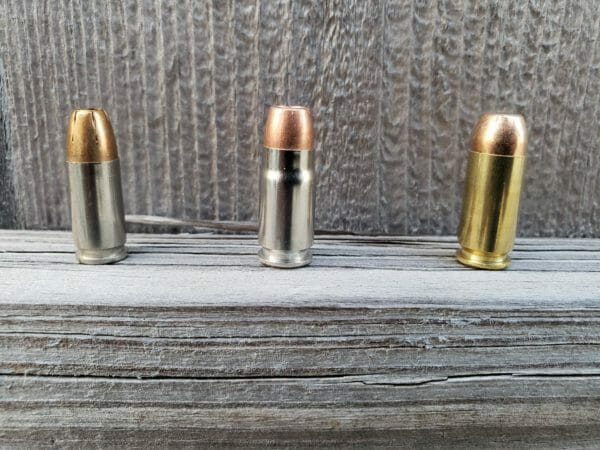
However, I don’t think this is a lost cause. Caliber conversions are helpful in places where the number of guns you can own are limited. It can also be helpful if you use calibers that require fewer parts to be swapped, such as .357SIG to .40S&W. Guns milled for optics can also benefit from caliber conversion, saving the user time and money, not having to send another slide off for weeks to months to get custom milled.
The Used Market
As more law enforcement agencies and private citizens dump their .40S&W guns, the market gets more favorable for those looking to gobble up these trade-ins. One department near me actually switched from 9mm to .40S&W within the past few years, buying guns and ammunition for pennies on the dollar. It was savings like this which led my family to jumping on the .40S&W bandwagon back in 2012. This is one of the more valid reasons I see for going the forty route in 2022, though it is temporary at best.

Unfortunately, a lot of these were bought up during the initial panic of 2020, when thousands of people decided it was time to buy a gun. That being said, you’ll still occasionally come across new trade-ins from time to time. Most people don’t shoot their guns that much, so snagging a gently used .40S&W will likely serve you well for a long time.
Final Thoughts on 40S&W
With modern bullet technology there is not much reason to choose .40S&W over a modern 9mm load. While it certainly performs admirably, and is widely available, it’s just not ideal in 2022. Maybe one day we’ll see a renaissance in bullet technology like we’ve seen with 9mm in the past few years, rocketing .40S&W back to the top of the game. Think about the pros and cons listed above, and decide what is right for you.
Author’s Note: Thanks to Greg Ellifritz and Reid Henrichs for their insight and support with this piece. Give them some love and support.
About Dan Reedy
Dan is an Air Force veteran, avid shooter, and dog dad. With a passion for teaching, he holds instructor certifications from Rangemaster, Agile Training & Consulting, and the NRA. He has trained with Darryl Bolke, Mike Pannone, Craig Douglas, among several other instructors, amassing over 400 hours of professional instruction thus far. In his spare time you’ll find him teaching handgun, shotgun, and less lethal classes.
Dan’s work has been published by Primer Peak, and The Kommando Blog, and he has been featured as a guest on Primary & Secondary.